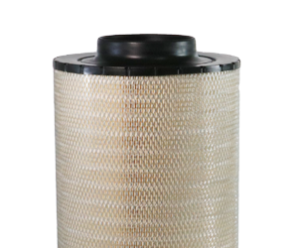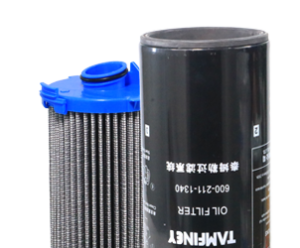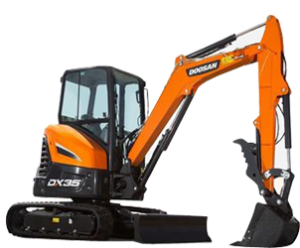
Return Filters
Return filters, also called return line filter, is an essential part for any hydraulic system. It is to filter the hydraulic oil or fluid in pressurized hydraulic systems before returning to the oil tank, so as to ensure that the oil in the tank is clean. When the replacement filter is not replaced in time, the bypass valve can be opened automatically to ensure the normal operation of the system.
The return-line filter provides ultimate flexibility in positioning – it can perform almost anywhere within the return line circuit, you can install controlled inline hydraulic filter (in the hydraulic tank line) or as a tank mounted filter (on top of the hydraulic tank,you can easily replace filter elements when needed). This mounting location ensures oil in the reservoir is clean and limits the re-introduction of wear-related contamination generated in the hydraulic system itself. Oil should then be clean and once again ready for recirculation by the pump. Return line filters can be fitted with air breather filters as additional equipment. The exact function is:
System cleanliness conservation , ensure maximum system efficiency.
Remove Contamination introduced through complete component failure or repairs made to system piping or flexible lines, that guarantee clean fluid being returned to your tank through the suction lines and further extend your system with less down time,also extending the fluid life.
Increased life of system components, Return filters are used as process and safety filters to protect pumps and hydraulic circuits from contamination
Significantly lower maintenance costs. Because the location of the filter has enough pressure to force the oil through the fine medium (usually 10 microns), but the pressure is not high enough to complicate the design of the filter or the housing. This advantage, coupled with a relatively low flow rate, means that higher filtration efficiency can be achieved at an economic cost.
Keep hydraulic oil clean, dry and cool. It only can capture free water instead of “dry” wet oil.
Types
Inline hydraulic filters, also called inline strainer, are installed on the low-pressure, return line side of a hydraulic system between components and tank, also can be installed before or after the boost pump. But inline hydraulic filter which are fitted with filter elements where the flow is from out to in,should preferably be installed in systems which have high operating pressure pulsations and where the filter housing has no bypass valve.
Hydraulic canister filters, sometimes called spin-on hydraulic filters, have an integrated filter replacement. Screw the canister onto a filter head and replace it when the filter is full to maintain correct flow and continue to remove particles. When the filter replacement becomes dirty or clogged, the canister is removed and a new canister is installed. They are usually low-pressure hydraulic filter housings, which are typically less expensive. Their purpose is to collect the dirt from around the circuit as the oil returns to the reservoir. Applications include general processing and industrial, mobile, and power transmission applications. Can use cellulose media and Synthetic media for different quality requirments.
Hydraulic cartridge filters, which need to be put in one assembly for using. The low to medium working pressure eco filter assemblies are also popular for using in return lines. These units have removable bowls with which filter cartridges are inserted. When a filter element becomes clogged, the bowl is screwed off, the cartridge removed and replaced, and then the bowl is screwed back on again. This design is more ecologically friendly, as it requires no bulky steel outer shell, is simpler to manufacture, and once used, cartridge elements are easier to drain of residual waste oil.
Tips
★ Return-line filters can be subject to flow surges (which contribute to poor filter performance) and they do not filter the drain lines.
★ Return line filter element can be sensitive to flow surges that can degrade their performance. These surges can be caused by multiple valves shifting simultaneously or from flow intensification from cylinders. This means it is important to size return-line filters for maximum anticipated flow.
★ Hydraulic return filter also do not clean fluid entering the reservoir through drain lines.
★ The back pressure created by the element can adversely affect the operation of and/or damage some components.
Working Pinciple
The oil in the hydraulic system enters the filter from the inlet, passes through the zigzag surface of the filter element, the impurities in the oil are adsorbed on the surface of the filter material, the clean liquid is immersed in the filter element, flows out from the outlet, and the clean liquid flows into the system. Such circulation ensures the cleanliness of the hydraulic system. Bypass valves open when backpressure reaches a predetermined level. The backpressure is created as the element becomes clogged with particles. As the bypass valve opens, fluid sidesteps the element itself, flowing around it to avoid excessive and damaging backpressure, especially in return lines. Suction and return filters are sized appropriately to handle the maximum flow possible with reasonably low backpressure. larger filter have higher dirt holding capacity.
Hydraulic return line filters have reliably remove the contamination from the operating fluid. Following this filtration, the fluid flows back into the tank.
Our Features
There is filtration back into the tank of the operating fluids returning from the system flow. All contamination particles which could penetrate the system or which were generated in the system are filtered out of the operating fluid before they return to the tank.
Flow rates up to 15,000 l/min
Pressure levels up to 25 bar
Numerous connection variants
Inexpensive filter housing and element
Our composite for filters:
Nickel-coated end caps, the surface treatment also can be spray molding, galvanizing, chrome plating and anodizing. Some also use high temperature and high pressure resistant nylon cover plate.
Supporting tube, According to the requirement, the thickness is 0.6-2mm, with spot welding and spiral method.
Inner and outer screens, Wire mesh according to the mesh required
Support layer, the material can be galvanized mesh, stainless steel mesh, plant fiber paper, copper mesh, etc. The function is:
(1) Support the filter layer so that the filter material will not be deformed or damaged under the pressure difference.
(2) Keep the process shape of the filter layer, make the filter layer contact the working medium evenly and fully, so as to improve the filtering effect.
Different depth layers for some of the highest dirt-holding capacities available.
Seals are mainly divided into gasket, seal ring, and shaped parts. The soft material has compressibility and elasticity. It is divided into radial seal and axial seal. The effect is to ensure the tightness of the connection between the filter element and other accessories.
Epoxy adhesives
Media
Filter media quality plays a part in sizing assemblies. It is a finer filtration (i.e., lower micron rating), is more restrictive to flow because of the smaller gaps in the media, which are required to trap smaller particles. Especially the premium synthetic depth-media has a higher dirt holding capacity and will take longer to clog than cheap paper or cellulose media. If you are unsure of the variables, it is advised to oversize the element and to use a high quality medium. Or you can check the filter rating directly in the testing lab. There are two types of material in the market, cellulose, synthetic Micro fiberglass.
Cellulose Media (Traditional)
Cellulose paper hydraulic oil filter is made of paper and polyester fiber, which is a single fold structure and then folded and assembled into finished products. Polyester is used to absorb water. Although its filtering effect is not as good as that of micro crystalline glass and does not contain too much dirt, it is relatively cheap and can be recycled when it is no longer useful. Cellulose can also absorb water, which may or may not be beneficial. They can be used to remove water from the system, but if this is not the intended effect and there is water in the system, the filter element will still absorb water. However, if the effect is not ideal, it will still absorb water, increase the pressure drop, and make the filter look blocked. Medium flow resistance is small, suitable for high flow applications. The efficiency is 98% at 40μm.
Synthetic Media, whose filtering performance is better than cellulose, a little worse than micro fiberglass. But the price is much lower than glassfiber. Medium flow resistance is small, suitable for medium flow applications, and more widely used. But it can’t be cleaned and reused. When the filter element is blocked, it must be replaced.
Micro fiber glass, Exacting efficiency for desired particle size fibreglass, also called micro glass is a type of synthetic filter media. Fiberglass hydraulic filtrations are considered to provide the best filtration quality. They are made by bonding micro-fiberglass material with resin which is randomly set into a multi-layer composite. Multiple thickness and stiffness options are available to tailor the composite to your application needs. Because of the finer weave as well as the presence of multiple layers, this type of filter is more efficient at capturing fine particulate matter and has a much greater dirt-holding capacity than cellulose filter elements. They are used in systems which are particularly sensitive to contamination, such as servo valves and piston pumps. Combine particle and water removal by using micro glass and absorbent layer.
Model No. | Tradional | Ahlstrom | Micro- |
|
Grammage g/m2 | 80±5 | 154 | 130±10 |
|
Thickness (mm) | 0.4±0.05 | 0.53 | 0.50±0.02 |
|
Pemeability CFM(△P=200paL㎡*s) | 340 | 207 | 250 |
|
Air flow resistance mm/H2O | 40 | 45±0.0 | 30 |
|
Max Pore μm | ≤40 | 55 | 20 |
|
Bursting strength (kpa) | 260 | 300 | — |
|
Resin content (%) | 20 | 19 | — |
|
Volatiles (%) | — | — | — |
|
Stiffness(mn*m) | 12 | 45 | — |
|
Tensile strength MD | ≥1.2 | ≥1.8 | 2.0 |
|
Tensile strength CD (kn/m) | ≥0.6 | ≥1.1 | — |
|
Our Advantages
The filter element has a high filtration ratio and stability. At the joint of the filter media, we have 3 different producing process:
The V-shaped bonding process
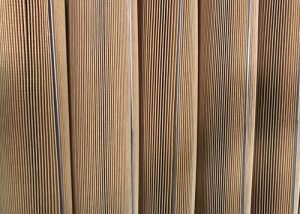
Cured polyurethane hot melt

High strength AB glue
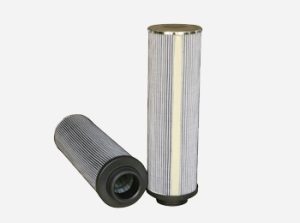
Due to the inherent strength of the filter element media and the solid structural support on both sides, the allowable pressure difference is quite large.
Resistent strength of the whole filter: from 0bar to the allowable working pressure, one million alternating load tests can be carried out 420bar Maximum working pressure Force.
The filter does not contain zinc and will not react with the oil fluid.
In the connection form of filter pipeline, the vertical installation form and pressure relief screw are all used to avoid oil leakage during maintenance.
FAQ
You can change the return filters after 1000hous working time.
Replacement steps:
1.Place the machine on the flat ground, fully retract the dipper, stick and boom cylinder to the ground, shut down the engine, and start the operation after the oil temperature drops
2. Screw the hydraulic system to pressure relief, release the pressure of the hydraulic system, cut off the power and close the pilot lock.
3. Press the vent valve of the hydraulic breathing valve to release the pressure in the hydraulic tank.
4. Open the filter element cover, take out the spring and filter element.
5. Replace filter element and sealing ring respectively, put back spring and install filter element cover
Pressure: The bypass check valve usually requires 10 to 50 psi to open. The bypass pressure should be high enough to stop fluid from going around the filter except under unusual conditions, but low enough to keep the filter element and housing seal from being damaged. when the oil return is switched on suddenly under high pressure, there will be impact, so the filter with large flow shall be selected. If the pressure is too large, back pressure valve shall be added to protect the filter.
Flow through: Even with a correctly sized return-line filter, the flow through it changes constantly. A steady flow through the element gives the most efficient filtration. If a filter passes constant flow, the bypass valve will not open until the filter fills with contaminants. This means only clean fluid leaves the filter.
In order to prevent the invasion of foreign matters and dust, return line filter plays the role of removing the metal powder and oil mud produced in the hydraulic circuit or the invasion of foreign matters due to the use of the crushing hammer and the replacement of the working device.
If it is not replaced regularly, the filter will be blocked and lose the filtering function. The filter without filtering function can not completely remove garbage and foreign matters, which will cause foreign matters to mix into the circuit.
As a result, it will cause serious faults such as wear and sintering of hydraulic device.
Failure to maintain the hydraulic oil filter can cause the following problems:
Pump damaged
Rotation and travel motor damaged
Oil cylinder leakage
Poor operation of control valve
Poor operation
Natural lowering of oil cylinder
1.Crushing hammer operation
In the operation of crushing hammer, foreign matters will be mixed in from the oil seal installation part at the front end of crushing hammer, and the hydraulic oil is easy to get dirty.Therefore, the filter is easy to block and the replacement interval is shorter.
2.Heavy load operation
In long-term continuous use and heavy operation, the temperature of hydraulic oil is easy to rise, and the deterioration rate of hydraulic oil will be accelerated.
3.Use of special working device
When replacing the working device, foreign matters are easy to enter from the hydraulic piping, and care must be taken.
When using the breaking hammer, there are many states with high circuit pressure, and the deterioration rate of hydraulic oil will be accelerated.

